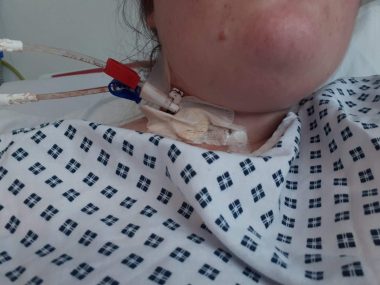Pain and Positivity: My Experience With Plasmapheresis

“‘Cause I would never break your heart/ I would only rearrange/ All the other working parts will stay in place.” — Biffy Clyro, a Scottish rock band
If you’ve spent any time in a hospital, you know that it never gets completely dark. There’s always a light flickering somewhere, a persistent reminder of your current gnarly reality, keeping you balanced on that precipice between sleep and wake.
I remember thinking this when I was admitted to Queen Elizabeth (QE) Hospital Birmingham, England, in the summer of 2018. Admittedly, much of this time is a blur now. Whether I’ve blocked it out or time has scrubbed away the details, I don’t know.
I was having a paralyzing MS relapse. My husband and I had been firefighting my symptoms for months since the relapse began symbiotically as I underwent my first Lemtrada (alemtuzumab) infusion that February. It was so aggressive that I walked into the hospital for the treatment and had to be wheeled out in a wheelchair. The aggressiveness was unforgiving and didn’t allow our emotions time to catch up. We were living day to day.
The first-line treatment for relapse, the steroid methylprednisolone, failed to make a dent in my symptoms, so I was swiftly admitted to the QE for plasmapheresis, or plasma exchange to clean my blood. This involved five separate treatments where my plasma was removed, separated from the blood cells, discarded, and returned to my body with a plasma replacement fluid. It was a roller coaster of an experience, and I was largely alone for it outside of visiting hours.
I was admitted late after several hours waiting for a bed, not knowing when one would become available. I hadn’t eaten since breakfast, and when I did get to my bed, I was offered a desolate cheese sandwich and some biscuits.
“Tomorrow will be better,” I kept telling myself. At least I’d have answers and a plan would be put in place. I don’t cope well with not knowing what’s going to happen, and I was distraught that I couldn’t find any patient accounts of what was in store for me with the plasmapheresis so that I could prepare.
Day two dawned, and I underwent baseline blood tests and an MRI to assess where the active inflammation was; being paralyzed from my waist down, there was clearly disease activity in my spine. Indeed, the MRI lit up like a Christmas tree.
I was informed that the plasmapheresis treatments required I get a central line. I didn’t think anything of it, as by now I was no stranger to needles or medical procedures.
Oh, how I underestimated what was about to happen. I don’t wish to sugarcoat this experience, because if I’d known, I could’ve prepared. It was one of the most traumatic procedures I’ve gone through.
Under local anesthetic, a tube was inserted into the side of my neck reaching down toward my heart. While I was numb from the anesthetic and thus not in pain, the pressure and sensation of the scalpel separating the tendons to make way for the tube was not something I wish to experience again. The room was hot, which contributed to a panic attack halfway through, which of course interrupted the procedure.

The central line in Beth’s neck for plasmapheresis. (Photo by Beth Shorthouse-Ullah)
The plasmapheresis itself, on the whole, was a walk in the park by comparison. Other than the hypnotic whirring of the machine next to me, I don’t recall much about it. What I do remember was my neurologist being concerned at the lack of change in my condition by the third treatment. He began discussing other options for treatment, for both the present active relapse and the disease-modifying therapy. At this point, he felt that Lemtrada hadn’t worked.
The turning point came after the fourth treatment. I couldn’t tell you what that turning point was, specifically, as it’s all rather blurry. I imagine my reflexes were getting stronger and transfers from bed to my wheelchair were more manageable. The bottom line: It was working! The removed plasma on day one was the color of apple cider, and following the final treatment, it was almost clear.
The awful central line, the hallucinations from the morphine, and the sleepless nights because of the pain and inconvenience of having something sticking out of my neck were all suddenly worth it.
Cleaning my blood of all the nasty antibodies contributing to my relapse made all the difference in the world. Recovery was still months away, but the worries about whether I’d be able to walk again had been replaced by a glimmer of hope.
Note: Multiple Sclerosis News Today is strictly a news and information website about the disease. It does not provide medical advice, diagnosis, or treatment. This content is not intended to be a substitute for professional medical advice, diagnosis, or treatment. Always seek the advice of your physician or other qualified health provider with any questions you may have regarding a medical condition. Never disregard professional medical advice or delay in seeking it because of something you have read on this website. The opinions expressed in this column are not those of Multiple Sclerosis News Today or its parent company, Bionews, and are intended to spark discussion about issues pertaining to multiple sclerosis.








Leave a comment
Fill in the required fields to post. Your email address will not be published.